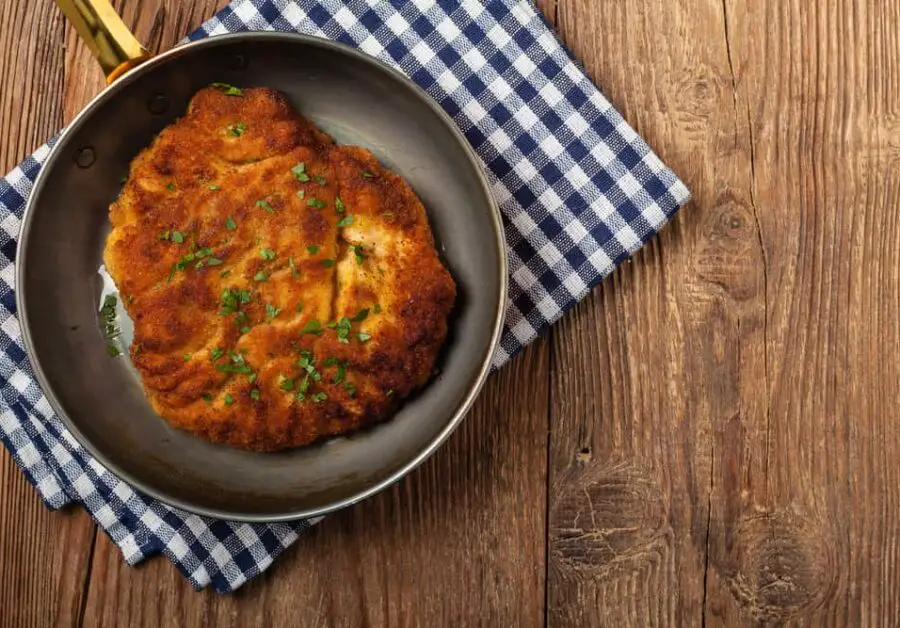If you’re new to specialty cookware, it’s possible you’ve never heard of a French skillet before. After all, a skillet is a skillet.
Right?
Not quite.
As you’ll soon discover, a French skillet not only has important design features that distinguish it from other types of pans but can make a big difference in the quality of the meal you’re preparing.
A French skillet is cookware with steep, sloping sides that are usually straight but are also sloped in some designs. They hold larger amounts of food than a typical frying pan thanks to its depth and width, which prevents excess spillage while cooking.
What Is The Purpose of a French Skillet?
Unlike regular frying pans, French skillets excel at cooking foods that need to be combined. It is specially designed to lock in moisture like oils in meats or vegetables (for browning) whereas pans allow for greater rates of evaporation (for frying).
What’s The Size Of A French Skillet?
The standard size of most French skillets is between 8 – 12 inches.
Are French Skillets Made In France?
The short answer is not necessarily. While this might have been true in the past, the term French skillet has nothing to do with where the cookware is made but rather its specific design features.
Even large manufacturers like Cuisinart have outsourced much of the production of their skillets to countries like China. The easiest way to see where it’s made is to check underneath the cookware itself to learn its country of origin.
Parts Of A French Skillet
Handle
Handles can be made of either metal, like stainless steel, wood or coated with heat-resistant materials like silicone which are all designed to remain cool to the touch while in use. French skillet handles are also generally longer than other pans. Some designs also feature a grab handle on the opposite side.
Rivets
Rivets are responsible for joining the handle to the pan. In some designs, welds are used instead of rivets.
Body
The body is designed with a flatter bottom that flares upward towards the rim. This allows for a larger surface area and more efficient heat dispersion. In terms of the material used, stainless steel is the most popular type for this type of cookware.
Rim & Sides
A majority of French skillets feature vertical sides that range from two to three inches in height. The height is considerably higher than most frying pans. Even though most designs have straighter sides, there are some available with rounded or sloping sides. Higher sides allow for a greater volume of food, while sloping sides are better for flipping foods.
Surface
Most French skillets are manufactured with stainless steel. Stainless steel offers significant advantages over other types of cooking surfaces like cast iron. Cookware constructed of stainless steel is lighter, thinner, and does a better job of transferring heat evenly and quickly. Last, stainless steel is corrosion-resistant meaning which extends the life of the skillet.
| Feature | Description |
|---|---|
| Handle | Can be made of metal, wood or coated with heat-resistant materials. Generally longer than other pans and may feature a grab handle. |
| Rivets | Join the handle to the pan. Some designs use welds instead. |
| Body | Has a flatter bottom that flares upward towards the rim for larger surface area and efficient heat dispersion. Typically made of stainless steel. |
| Rim & Sides | Feature vertical sides ranging from 2-3 inches in height. Some designs have straighter sides while others have rounded or sloping sides. |
| Surface | Most commonly made of stainless steel, which is lightweight, thinner, and transfers heat evenly and quickly. Also corrosion-resistant. |
What Can You Cook In A French Skillet?
The possibilities with French skillets are only limited to your imagination.
However, as mentioned previously, they excel at holding and combining liquids for sauces. Some popular ideas you might want to try include:
- Balsamic Glazed Chicken
- Beef & Broccoli Noodles
- Caprese Chicken
- Caprese Chicken Pasta
- Caprese Stuffed Chicken
- Chicken & Potatoes
- Chicken Alfredo
- Chicken Cordon Bleu
- Chicken Enchilada
- Chicken Parmesan
- Chicken Piccata
- Cilantro-Lime Chicken
- Cilantro-Lime Shrimp Pasta
- Coq Au Vin
- Creamy Tuscan Chicken
- Fettuccine Alfredo
- Garlic Butter Shrimp Pasta
- Goulash
- Mac & Cheese
- Pad Thai
- Pepper Steak
- Sesame-Ginger Beef
- Shepherd’s Pie
- Shrimp & Broccoli
- Shrimp Fried Rice
- Skillet Pork Chops
- Sloppy Joes
- Steak Fettuccine
- Teriyaki Chicken
- Tuscan Shrimp Penne

Hi, I’m Jenny. I have many interests and, some would say, eclectic passions. A few words that best describe me? Hmm, well… Amateur surfer, professional traveler, food lover and writer extraordinaire. Oh, and lover of all furry, four-legged creatures!

